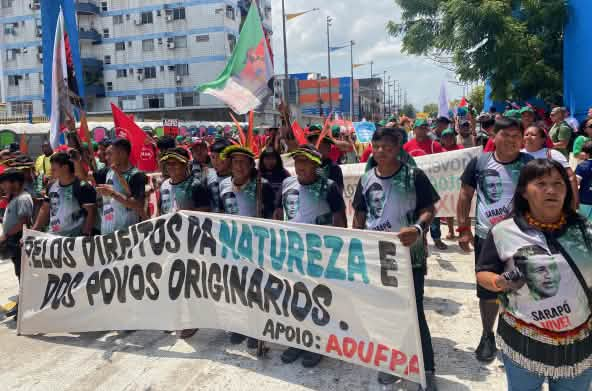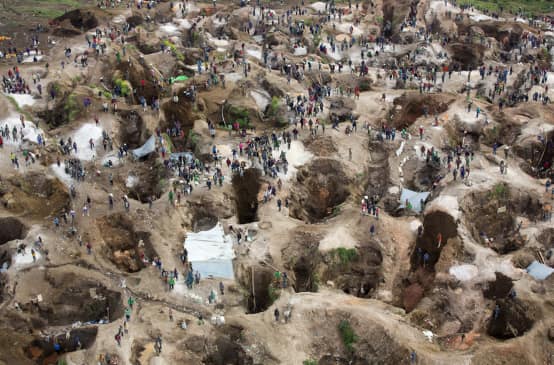Completed campaign
Peru: Save the rainforest of Alto Purús
In Southeastern Peru, a road through the rainforest is scheduled to be constructed – a road leading right through Alto Purús, one of the biggest national parks of the country. This protected area has been largely inaccessible until now. On account of this, the park still possesses a very rich biodiversity, and it is home to at least two uncontacted Indian tribes. Environmentalists and indigenous organisations oppose the project, since they are aware that building the new road would have catastrophic effects on the national park. Please support the preservation of the Alto Purús National Park by signing the letter of protest.
Peru has the second largest share of the Amazon rainforest in South America. But the pressures afflicting the Amazon region grow. In particular, the mining industry, oil production companies and infrastructure projects threaten the sensitive ecosytems. Even protected forest areas become the focus of attention for the economy.
Now, a new road is supposed to connect Peru to Brazil in order to simplify the countries’ trading activities. One road section passes right through Alto Purús, the most species-rich national park of Peru. Until now, 86 mammal species have been discovered there, and 21 of them are on the red list of threatened species. What is more, two Indian tribes live in the national park in voluntary isolation. The construction project is going to connect the cities of Puerto Esperanza and Iñapari. Scientists and environmental groups agree that building a road through the park puts an end to its natural and cultural diversity.
Additional information and original text of the letter
Please support the environmental groups and indigenous organisations of Peru in their struggle for the preservation of the Alto Purús National Park. Write to the Peruvian president and the prime minister and ask them to determine a course of action in compliance with national and international laws.
A road to pursuing the economic interests of a few
“The richness of the region through which the road is supposed to pass should be mentioned. In particular, the rainforest as a source of timber production and the possibility of large-scale stock breeding [...]", the euphoric project report reads. The aim that is to be achieved by building the road is clear. Formerly wild areas of the Amazon are scheduled to be made economically accessible. The proposed road will connect the Peruvian cities of Puerto Esperanza (Madre de Dios) and Iñapari (Ucayali), and the construction plans are subject to the South American infrastructure project IIRSA (1). IIRSA is a development plan to interconnect the traffic and transportation routes of South American countries. The road through the Alto Purús National Park is part of section 3 of IIRSA’s “Peru-Brazil-Bolivia Hub”. Linking the Brazilian border to Peru’s Pacific coast is the long-term goal. The Catholic Church in Párroco supports the building of the road through Alto Purús and considers the construction project as bringing “salvation” to the indigenous people living there in voluntary isolation.
Alto Purús – A natural resource across borders
If the road is built, it will cut through one of the largest national parks in Peru. The region is a protected area since 2004 and covers 2.74 million hectares of land. Alto Purús is connected with other parks in Peru, Brazil and Bolivia – thus, it is part of the biggest network of protected areas in the Amazon. In large part, Alto Purús is accessible only by air. For this reason, the park has an almost intact ecosystem that is characterised by its immense variety of species. Particularly rare and endangered species such as the giant otter, the jaguar and the red-faced black spider monkey live there. Until now, scientists have discovered 86 mammal species and 510 species of bird. Scholars speak out against the building of the road, since it would inevitably open Alto Purús to illegal logging and poaching. Studies (2) show that it is the custom in the Amazon region to cut down a large area of at least 50 kilometers on both sides of the track in the course of road construction. This would mean disaster for the ecosystem of Alto Purús.
Cultural diversity in the Alto Purús National Park
More than 85 per cent of the population in the Purús Province belong to indigenous tribes such as Juni kuin, Sharanahua or Culina. The majority rejects the building of the road. “We do not believe in the government’s promises of progress. The new road will only bring more poverty, more settlers and the destruction of nature”, says Flora, a member of the regional indigenous umbrella organisation FECONAPU. In addition to that, the construction project threatens the existence of the indigenous people of the Mashco Piro (3) and the Curanjeño. These Indian tribes living in voluntary isolation in the national park would come into conflict with loggers and poachers, and they would be helpless in the face of the “diseases of modern civilisation”. In fact, the population has the law on its side: In September 2011, the new Peruvian government shaped ILO Convention 169 into national law. According to the approved consultation law, the people affected by economic projects have to consent to them first. What is more, the national park is subject to strict protection regulations. Flora explains: “In our view, the seed for development lies in our creativity – in working constructively with our future generations in mind and in dealing with plant and animal life as well as biodiversity in a resonsible way. The forest is life.”
Here, you can find the original text of the declaration of FECONAPU.
Links:
(1) http://www.iirsa.org/index.asp?CodIdioma=ESP
(3) English: http://www.guardian.co.uk/world/2012/jan/31/peru-outsiders-uncontacted-amazon-tribe
To:
Sr. Ollanta Humala, President of Peru
Carbon copy:
Sr. Oscar Valdés, Prime Minister
Sr. Daniel Fernando Abugattás Majluf, President of the Congress
Dear Mr. President,
I am writing out of concern for the ecological preservation of the Alto Purús National Park. With this letter, I voice my support for the demands of the indigenous population of the Purús Province, represented by their umbrella organisation FECONAPU. I urge you to prevent the building of the road through the national park, to stand up for the protection and preservation of the ecosystem of Alto Purús and to speak out for the indigenous communities. With your seminal decision to implement ILO Convention 169 in national law, you have already shown your respect for the cultures of the indigenous people of Peru and you have acknowledged their rights to self-determination and co-determination. Consequentially, this law needs to be applied in practice.
Sincerely,
[Your Name]
Declaration of FECONAPU
The indigenous communities of the Purús Province, represented by the Federacion de Comunidades de la Provincia de Purus (FECONAPU), reject the building of the new road and they are determined to defend their territory, the home of the Mashco Piro Indians!
1. The tribes of the Cashinahua, Sharanahua, Culina, Chaninahua, Mastanahua and Amahuaca have been living in the territory of the Purús Province for a very long time. We see ourselves as the guardians of the Amazon rainforest in this area of great biological and cultural diversity.
2. This territory is also home to our brothers of the Mashco Piro tribe who have decided to live autonomously in voluntary isolation.
3. Involving the indigenous population by means of participation and direct consultation, the government set up the Alto Purús National Park and the refuge for the Mashco Piro in 2005. Ever since, we are fighting for the preservation of our rights and for the protection of our land.
4. In addition, there is an ongoing pressure imposed by the local church of Párocco to build the road – in order to “solve the problematic situation of the uncontacted tribes living in the Purús Province in the Ucayali Region”.
5. At the organisation’s third and fourth general assemblies in 2005 and 2007, FECONAPU decided upon defending the indigenous territories and the refuge for the Mashco Piro. Thus, FECONAPU speaks out against the building of the proposed road. These decisions are considered mandatory by the indigenous population of the Purús Province, and the population’s representatives are committed to them.
6. We speak out against the construction of the road for the following reasons. Building it means:
- the loss of environmental services such as drinking water supplies and the deterioration of the natural microclimate
- the loss of food security (meat, fish, fruit etc.) which would affect the tribes living in voluntary isolation in particular
- the loss of the refuges providing protection for the uncontacted tribes whose existence has been confirmed and whose culture and life choices need to be respected by us
- the loss of biodiversity which implicates losing the opportunity to gain new scientific knowledge in the field of medicine and other sciences by exploring this ecosystem
- the possibility of uncontrolled land occupation by settlers.
7. We urge our brothers to support us and to assert their rights with regard to planned economic developments – now more than ever. By way of the approved consultation law, the public authorities are legally bound to include us in making decisions.
Puerto Esperanza, Purús, 11/15/2011
Signed by representatives of ECOPURÚS and FECONAPU and the committee president of the national park administration.

